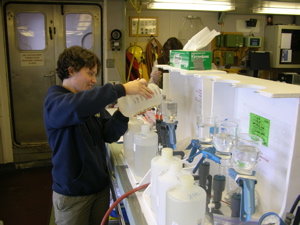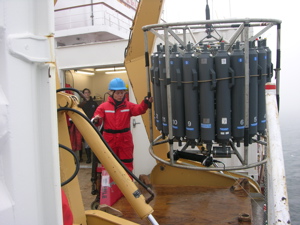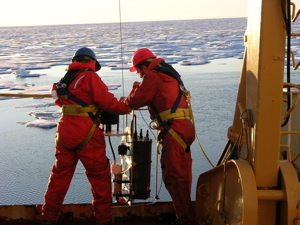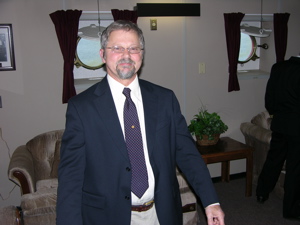Luc RainvilleAugust 4, 2007
The water in the Arctic ocean is very clear, especially in the middle of the Canada Basin. It's always very impressive to see the CTD being lowered in the water and be able to watch it going down for 50 meters or so. Clear, beautiful blue water. But this doesn't mean that there is nothing in the water!!! Although there is less sediments and particles here than, say, in the North Atlantic, there is tons of information to gain from looking at the turbidity of the water and what kind of particles are suspended. We can have an idea of how much stuff is in the water by looking at the transmissometer data, mounted on the CTD. This sensor measures the transparency of the water. The traditional and most proven way to study suspended particles is to take a 4-6 liter sample of the water column with the bottles on the CTD rosette and make it go through a very fine filter. Because the filter is designed to catch the smallest particles, water only trickles through it. Filtering takes for ever! Then back in the laboratory on shore, one can analyze the content on the filter and determine what particles (examples) are in the water. For her Ph.D. project, Jennifer Jackson, from University of British Columbia, is trying to relate the transmissometer data (and using the other real-time measurements on the CTD) to the water samples. Another way to do it is to use the brut force and filter directly at the depths you are interested in suing powerful pumps. If you filter a large volume of water in situ and only bring back the filter, you have a bigger signal. The problem is that filtering always takes time, and your pump has to be stopped at the depth you are interested in. Steve Manganini, from WHOI, is trying this method and wants to compare his results to more traditional methods, and to the particles that he collects in sediment traps over the course of one year (that will be the subject of a later dispatch). Today Steve put such a pump in the water, lowered it to 2000 m, filtered 500 liters during one hour, and brought it back to the surface. Later in the cruise he's hoping to filter for 2 hours at 3000 m (the depth of his sediment traps on the moorings) a couple of times. It will be interesting to compare the results!
Last updated: October 7, 2019 | |||||||||||||||||||||||
Copyright ©2007 Woods Hole Oceanographic Institution, All Rights Reserved, Privacy Policy. | |||||||||||||||||||||||






